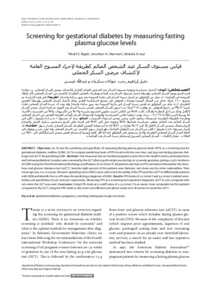Document
Screening for gestational diabetes by measuring fasting plasma glucose levels.
Contributors
Skerman, Jonathan H., Author
Issa, Abdulla A., Author
Other titles
قياس مستوى السكر عند الشخص الصائم كطريقة لإجراء المسوح العامة لإكتشاف مرضى السكر الحملي
Publisher
College of Medicine, Sultan Qaboos University.
Gregorian
2003-04
Language
English
English abstract
Objectives: (a) To test the sensitivity and specificity of measuring fasting plasma glucose levels (FPG) as a screening test for gestational diabetes mellitus (GDM). (b) To compare predicting levels of FPG levels with the one-hour, oral 50g non-fasting glucose challenge test (GCT) for predicting GDM. Methods: One thousand and six hundred pregnant women from the Health Centres, antenatal clinics and Salmaniya Medical Complex were screened by the GCT after 50g of oral glucose during 26–32 weeks gestation, giving a 13.5% incidence of GDM (using the Third International Workshop cutoff values of 7.8 mmol /l). All patients also had an FPG estimation followed by the three-hour oral glucose tolerance test (oGTT). Seventy eight percent of the patients were Bahraini, 19% Asian and 3% other nationalities. Their mean age was 27.2+0.2 years. Receiver-operating curves (ROC) were used to test the ability of the FPG and the oGTT to differentiate patients with GDM and identify the cut off values for predicting a diagnosis of GDM. Results: FPG levels of 5.6 mmol /l and 5.4 mmol /l yielded sensitivities and specificities of 94% and 93% respectively. Measuring FPG as a screening test required a diagnostic oGTT in 32% compared with 13% when the GCT was used. Conclusion: Using FPG levels at a cutoff value of ≥ 5.5 mmol /l is an easier, more acceptable test for patients compared to the GCT. Using the FPG levels is also more cost effective and allows nearly 70% of women to avoid the oGTT.
Member of
Resource URL
Citation
Rajab, Khalil E., Skerman, Jonathan H., & Issa, Abdulla A. (2003). Screening for Gestational Diabetes by Measuring Fasting Plasma Glucose Levels. Sultan Qaboos University Medical Journal, 5 (1-2), 5–8.
Arabic abstract
الهدف: أ - إختبار حساسية ونوعية مستوى السكر عند الشخص الصائم كإختبار لإكتشاف مرضى السكر الحملي. ب. مقارنة قدره التنبؤ بوجود السكر الحملي بواسطة إختبار مستوى السكر عند الصائم ومقارنته بالفحص التقليدي للكشف عن السكر الحملي (أي إعطاء المريضة غير الصائمة ٥٠ جرام من الجلوكوز ثم إختبار نسبة السكر في بلازما المريضة بعد مرور ساعة واحدة. الطريقة في هذه الدراسة تم تجميع ١٦٠٠ إمرأة حامل من المراكز الصحية وعيادات الحوامل في مجمع السلمانية الطبي وذلك لإختبار السكر الحملي بواسطة الفحص التقليدي ٥٠ جرام من الجلوكوز ثم فحص نسبة السكر في بلازما المريضة بعد مرور ساعة واحدة) وقد وجد أن نسبة السكر الحملي تعادل تقریبا ۱۳% من جميع الحوامل. ثم وظفت ۲۱۷ أمرأة ثبت لديهن السكر الحملى لقياس نسبة السكر بعد الصوم ثم إجراء إختبار منحى السكر الكامل وذلك من أجل المقارنه .والتأكد كانت %۷۸ من اللاتي اجريت عليهن المسوح بحرينية و ۱۹% من الآسيويات و ۳% من الجنسيات الأخرى أما وسيط السن فكان ٢٧,٣ سنة. وتمت عملية قياس الحساسية والنوعية لإستعمال السكر الصائم كطريقة للفحص عن السكر الحملي ومقارنته بالطريقة التقليدية باستعمال برنامج خاص يدعى منحي استقبال المميزات. النتائج وجد أن مستوى ٥،٦ و ٥،٤ مليمول / اللتر في السكر الصائم عند الحامل يعطي حساسية مقدارها ٩٤ ونوعية تصل إلى %9% في قدرته على التنبؤ بتشخيص سكري الحمل ولا يحتاج إلى استعمال منحنى السكر الكامل إلا في %۱۳% مقارنه ب ۳۳% إذا ما استعملنا الفحص التقليدي للسكر الحملي إختبار سهل الخلاصة: إن إختيار مستوى ٥,٥٨ مليمول / اللتر من السكر عند الحوامل الصائمات هو إختبار سهل للكشف عن السكر الحملي وله تقبل حسن ويفوق في الدقه اختبار السكر الحملي التقليدي والذي يستعمل في الجلوكوز كما أنه أقل كلفة ويجنبنا إستخدام فحص منحي السكر الكامل في ٧٠% من الحالات.
Category
Journal articles

